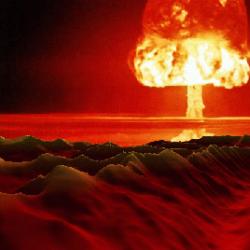Who Invented the Seismograph - When Was It Invented? Seismograph. Drawing, description Seismographs used by scientists
Seismograph
Seismograph
Seismograph- a special measuring device that is used to detect and record all types of seismic waves. In most cases, a seismograph has a load with a spring attachment, which remains stationary during an earthquake, while the rest of the instrument (body, support) moves and shifts relative to the load. Some seismographs are sensitive to horizontal movements, others to vertical ones. The waves are recorded by a vibrating pen on a moving paper tape. There are also electronic seismographs (without paper tape).
Until recently, mechanical or electromechanical devices were mainly used as sensitive elements of seismographs. It is quite natural that the cost of such instruments containing elements of precision mechanics is so high that they are practically inaccessible to an ordinary researcher, and the complexity of the mechanical system and, accordingly, the requirements for the quality of its execution actually mean that it is impossible to manufacture such instruments on an industrial scale.
The rapid development of microelectronics and quantum optics has now led to the emergence of serious competitors to traditional mechanical seismographs in the mid- and high-frequency region of the spectrum. However, such devices based on micromachining technology, fiber optics or laser physics have very unsatisfactory characteristics in the infra-low frequency region (up to several tens of Hz), which is a problem for seismology (in particular, the organization of teleseismic networks).
There is also a fundamentally different approach to the construction of the mechanical system of a seismograph - the replacement of a solid inertial mass with a liquid electrolyte. In such devices, an external seismic signal induces a flow of working fluid, which, in turn, is converted into an electrical current using an electrode system. Sensing elements of this type are called molecular-electronic. The advantages of seismographs with liquid inertial mass are low cost, long service life (about 15 years), and the absence of precision mechanics elements, which greatly simplifies their manufacture and operation.
Computerized seismic systems
With the advent of computers and analog-to-digital converters, the functionality of seismic equipment has increased dramatically. It became possible to simultaneously record and analyze signals from several seismic sensors in real time, take into account the spectra of signals. This provided a fundamental leap in the information content of seismic measurements.
Seismograph examples
- Molecular electron seismograph. .
- Autonomous bottom seismograph. . Archived from the original on December 3, 2012.
Wikimedia Foundation. 2010 .
Synonyms:See what "Seismograph" is in other dictionaries:
Seismograph … Spelling Dictionary
- (Greek, from seismos vibration, concussion, and I write grapho). Apparatus for observing earthquakes. Dictionary of foreign words included in the Russian language. Chudinov A.N., 1910. SEISMOGRAPH Greek, from seismos, shock, and grapho, I am writing. Apparatus for ... ... Dictionary of foreign words of the Russian language
Syn. seismic term. Geological dictionary: in 2 volumes. M.: Nedra. Edited by K. N. Paffengolts et al. 1978 ... Geological Encyclopedia
Geophone, seismic receiver Dictionary of Russian synonyms. seismograph noun, number of synonyms: 2 geophone (1) … Synonym dictionary
- (from seismic ... and ... graph) a device for recording vibrations of the earth's surface during earthquakes or explosions. The main parts of the seismograph pendulum and recording device ... Big Encyclopedic Dictionary
- (seismometer), a device for measuring and recording SEISMIC WAVES caused by movement (EARTHQUAKE or explosion) in the earth's crust. Vibrations are recorded using a writing element on a rotating drum. Some seismographs are able to capture ... ... Scientific and technical encyclopedic dictionary
SEISMOGRAPH, seismograph, husband. (from Greek seismos shaking and grapho I write) (geol.). Device for automatic recording of vibrations of the earth's surface. Explanatory Dictionary of Ushakov. D.N. Ushakov. 1935 1940 ... Explanatory Dictionary of Ushakov
SEISMOGRAPH, a, husband. A device for recording vibrations of the earth's surface during earthquakes or explosions. Explanatory dictionary of Ozhegov. S.I. Ozhegov, N.Yu. Shvedova. 1949 1992 ... Explanatory dictionary of Ozhegov
Seismograph- - a device designed to record vibrations of the earth's surface caused by seismic waves. It consists of a pendulum, for example, a steel weight, which is suspended on a spring or thin wire from a stand firmly fixed in the ground. ... ... Oil and gas microencyclopedia
seismograph- A device for converting mechanical vibrations of the soil into electrical and subsequent recording on photosensitive paper. [Glossary of geological terms and concepts. Tomsk State University] Topics geology, geophysics Generalizing ... ... Technical Translator's Handbook
Books
- Game worlds: from homo ludens to a gamer, Tendryakova Maria Vladimirovna. The author refers to the widest range of games: from archaic games, divination games and competitions to newfangled computer games. Through the prism of the game and the transformations taking place with games - the fashion for ...
The seismograph consists of a pendulum, for example, a steel weight, which is suspended on a spring or thin wire from a stand firmly fixed in the ground. The pendulum is connected to a pen that draws a continuous line on a paper strip. With rapid vibrations of the soil, the paper shakes along with it, while the pendulum with the pen remains motionless by inertia. A wavy line appears on the paper, reflecting the vibrations of the soil. A curve on a paper tape mounted on a slowly rotating drum under a pen that draws a line is called a seismogram.


The operation of a seismograph is based on the principle that freely suspended pendulums during earthquakes remain almost motionless. The upper seismograph captures horizontal, and the lower seismograph captures vertical vibrations of the earth.

Three red drums about 20 cm high are seismograph receivers at a modern seismic station. The standing drum receives vertical oscillations of the soil, on one of the lying drums oscillations are noted in the north-south direction, on the other east-west. The device standing nearby registers the slowest underground shifts, which are not amenable to the other three receivers. The readings of all four instruments are transmitted to complex electronic devices for recording seismograms.
In 1891, one of the strongest earthquakes ever experienced in Japan devastated vast areas west of Tokyo. An eyewitness described the destruction as follows: "Deep failures formed on the surface; the dams that protected the lowlands from floods collapsed, almost all the houses were destroyed, the mountain slopes slid into the abyss. 10,000 people died, 20,000 were injured."

Seismogram of the earthquake that shook November 8, 1983 at 1 o'clock. 49m. Belgium, the Netherlands and North Rhine - Westphalia, recorded by the seismic station of Hamburg. The top curve shows vertical vibrations, the bottom curve shows horizontal vibrations. The earthquake killed two people.
Japanese geologists who studied the consequences of this catastrophe were surprised to find that there was no clearly defined epicenter. The surface was cut by an almost straight fissure about 110 km long, as if cut into two parts by a giant knife, and the edges of the cut were shifted relative to each other. “The earth,” one of the geologists reported, “is torn into huge blocks and raised. It looks like a trace left by a giant mole. The streets and roads are torn apart, multi-meter gaps gape at them; two trees that had previously stood side by side in the east-west direction, now found themselves at a fair distance, and along the north-south axis. The earthquake moved one of them to the north, the other to the south."
It's hard to imagine, but every year on our planet there are about a million earthquakes! Of course, these are mostly weak tremors. Earthquakes of destructive power occur much less frequently, on average, once every two weeks. Fortunately, most of them occur at the bottom of the oceans and do not bring any trouble to mankind, unless a tsunami occurs as a result of seismic displacements.
Everyone knows about the catastrophic consequences of earthquakes: tectonic activity awakens volcanoes, giant tidal waves wash entire cities into the ocean, faults and landslides destroy buildings, cause fires and floods and claim hundreds and thousands of human lives.
Therefore, people at all times sought to study earthquakes and prevent their consequences. So, Aristotle in the IV century. to i. e. believed that atmospheric vortices penetrate into the earth, in which there are many voids and cracks. The whirlwinds are intensified by fire and look for a way out, causing earthquakes and volcanic eruptions. Aristotle also observed the movements of the soil during earthquakes and tried to classify them, identifying six types of movements: up and down, from side to side, etc.
The first known attempt to make an earthquake predictor was by the Chinese philosopher and astronomer Zhang Heng. In China, these natural disasters have happened and happen extremely often, moreover, three of the four largest earthquakes in human history occurred in China. And in 132, Zhang Heng invented a device to which he gave the name Houfeng "earthquake weather vane" and which could record the vibrations of the earth's surface and the direction of their propagation. Houfeng became the world's first seismograph (from the Greek seismos "fluctuation" and grapho "I write") a device for detecting and recording seismic waves.
Aftermath of the 1906 San Francisco earthquake
Strictly speaking, the device was more like a seismoscope (from the Greek skopeo "I look"), because its readings were recorded not automatically, but by the observer's hand.
Houfeng was made of copper in the shape of a wine vessel with a diameter of 180 cm and thin walls. Outside the vessel were eight dragons. The dragon heads pointed in eight directions: east, south, west, north, northeast, southeast, northwest, and southwest. Each dragon held a copper ball in its mouth, and under its head sat an open-mouthed toad. It is assumed that a pendulum with rods was installed vertically inside the vessel, which were attached to the heads of dragons. When, as a result of an earthquake, the pendulum was set in motion, a rod connected to the head facing the shock opened the dragon's mouth, and the ball rolled out of it into the mouth of the corresponding toad. If two balls rolled out, one could assume the strength of the earthquake. If the device was at the epicenter, then all the balls rolled out. Instrument observers could immediately record the time and direction of the earthquake. The device was very sensitive: it caught even weak tremors, the epicenter of which was 600 km away from it. In 138, this seismograph accurately indicated an earthquake that occurred in the Lunxi region.
In Europe, earthquakes began to be seriously studied much later. In 1862, the book of the Irish engineer Robert Malet "The Great Neapolitan Earthquake of 1857: Basic Principles of Seismological Observations" was published. Malet made an expedition to Italy and made a map of the affected territory, dividing it into four zones. The zones introduced by Malet represent the first, rather primitive scale of shaking intensity.
But seismology as a science began to develop only with the widespread appearance and introduction into practice of instruments for recording soil vibrations, that is, with the advent of scientific seismometry.
In 1855, the Italian Luigi Palmieri invented a seismograph capable of recording distant earthquakes. He acted according to the following principle: during an earthquake, mercury spilled from a spherical volume into a special container, depending on the direction of vibrations. The container contact indicator stopped the clock, indicating the exact time, and started recording the earth's vibrations on the drum.
In 1875, another Italian scientist, Filippo Sechi, designed a seismograph that turned on the clock at the time of the first shock and recorded the first oscillation. The first seismic record that has come down to us was made using this device in 1887. After that, rapid progress began in the field of creating instruments for recording soil vibrations. In 1892, a group of English scientists working in Japan created the first fairly easy-to-use instrument, John Milne's seismograph. Already in 1900, a worldwide network of 40 seismic stations equipped with Milne instruments was functioning.
A seismograph consists of a pendulum of one design or another and a system for recording its oscillations. According to the method of registration of pendulum oscillations, seismographs can be divided into devices with direct registration, transducers of mechanical vibrations and seismographs with feedback.
Direct recording seismographs use a mechanical or optical recording method. Initially, with a mechanical recording method, a pen was placed at the end of the pendulum, scratching a line on smoked paper, which was then covered with a fixing composition. But the pendulum of a seismograph with mechanical registration is strongly influenced by the friction of the pen on the paper. To reduce this influence, a very large mass of the pendulum is needed.
With the optical method of recording, a mirror was fixed on the axis of rotation, which was illuminated through the lens, and the reflected beam fell on photographic paper wound on a rotating drum.
The direct recording method is still used in seismically active zones, where soil movements are quite large. But to register weak earthquakes and at large distances from the sources, it is necessary to amplify the oscillations of the pendulum. This is carried out by various converters of mechanical displacements into electric current.

A diagram of the propagation of seismic waves from the source of an earthquake, or hypocenter (bottom) and epicenter (top).
The transformation of mechanical vibrations was first proposed by the Russian scientist Boris Borisovich Golitsyn in 1902. It was a galvanometric registration based on the electrodynamic method. An induction coil rigidly fastened to the pendulum was placed in the field of a permanent magnet. When the pendulum oscillated, the magnetic flux changed, an electromotive force arose in the coil, and the current was recorded by a mirror galvanometer. A beam of light was directed to the mirror of the galvanometer, and the reflected beam, as in the optical method, fell on photographic paper. Such seismographs won worldwide recognition for many decades to come.
Recently, the so-called parametric converters have become widespread. In these transducers, mechanical movement (movement of the mass of the pendulum) causes a change in some parameter of the electrical circuit (for example, electrical resistance, capacitance, inductance, luminous flux, etc.).

B. Golitsyn.

Seismological station adit. The equipment installed there captures even the slightest vibrations of the soil.

Mobile installation for geophysical and seismological studies.
A change in this parameter leads to a change in the current in the circuit, and in this case it is the displacement of the pendulum (and not its speed) that determines the magnitude of the electrical signal. Of the various parametric transducers in seismometry, two are mainly used photoelectric and capacitive. The most popular is the Benioff capacitive transducer. Among the selection criteria, the main ones turned out to be the simplicity of the device, linearity, low level of intrinsic noise, efficiency in power supply.
Seismographs are sensitive to vertical vibrations of the earth or to horizontal ones. To observe the movement of the soil in all directions, three seismographs are usually used: one with a vertical pendulum and two with horizontal ones oriented east and north. Vertical and horizontal pendulums differ in their design, so it turns out to be quite difficult to achieve complete identity of their frequency characteristics.
With the advent of computers and analog-to-digital converters, the functionality of seismic equipment has increased dramatically. It became possible to simultaneously record and analyze signals from several seismic sensors in real time, take into account the spectra of signals. This provided a fundamental leap in the information content of seismic measurements.
Seismographs are used primarily to study the earthquake phenomenon itself. With their help, it is possible to determine in an instrumental way the strength of an earthquake, the place of its occurrence, the frequency of occurrence in a given place, and the predominant places of occurrence of earthquakes.

Seismological station equipment in New Zealand.
Basic information about the internal structure of the Earth is also obtained from seismic data by interpreting the fields of seismic waves caused by earthquakes and powerful explosions and observed on the Earth's surface.
With the help of recording seismic waves, studies of the structure of the earth's crust are also being carried out. For example, studies in the 1950s show that the thickness of the crustal layers, as well as the wave speeds in them, vary from place to place. In Central Asia, the thickness of the crust reaches 50 km, and in Japan -15 km. A map of the thickness of the earth's crust has been created.
It can be expected that new technologies in inertial and gravitational measurement methods will soon appear. It is possible that it is the seismographs of the new generation that will be able to detect gravitational waves in the Universe.

Seismograph recording
Scientists around the world are developing projects to create satellite earthquake warning systems. One such project is the Interferometric-Synthetic Aperture Radar (InSAR). This radar, or rather radars, monitors the displacement of tectonic plates in a certain area, and thanks to the data they receive, even subtle displacements can be recorded. Scientists believe that due to this sensitivity, it is possible to more accurately determine areas of high voltage seismically hazardous zones.

Question 1. What is the earth's crust?
The Earth's crust is the outer hard shell (crust) of the Earth, the upper part of the lithosphere.
Question 2. What are the types of the earth's crust?
Continental crust. It consists of several layers. The top is a layer of sedimentary rocks. The thickness of this layer is up to 10-15 km. Beneath it lies a granite layer. The rocks that compose it are similar in their physical properties to granite. The thickness of this layer is from 5 to 15 km. Under the granite layer is a basalt layer, consisting of basalt and rocks, the physical properties of which resemble basalt. The thickness of this layer is from 10 to 35 km.
Oceanic crust. It differs from the continental crust in that it does not have a granite layer or it is very thin, so the thickness of the oceanic crust is only 6-15 km.
Question 3. How do the types of the earth's crust differ from each other?
Types of the earth's crust differ from each other in thickness. The total thickness of the continental crust reaches 30-70 km. The thickness of the oceanic earth's crust is only 6-15 km.
Question 4. Why do we not notice most of the movements of the earth's crust?
Because the earth's crust moves very slowly, and only with friction between the plates do earthquakes occur.
Question 5. Where and how does the solid shell of the Earth move?
Each point of the earth's crust moves: rises up or falls down, shifts forward, backward, to the right or left relative to other points. Their joint movements lead to the fact that somewhere the earth's crust slowly rises, somewhere it sinks.
Question 6. What types of movement are characteristic of the earth's crust?
Slow, or secular, movements of the earth's crust are vertical movements of the earth's surface at a speed of up to several centimeters per year, associated with the action of processes occurring in its depths.
Earthquakes are associated with ruptures and violations of the integrity of rocks in the lithosphere. The area in which an earthquake originates is called the earthquake focus, and the area located on the surface of the Earth exactly above the focus is called the epicenter. At the epicenter, the vibrations of the earth's crust are especially strong.
Question 7. What is the name of the science that studies the movements of the earth's crust?
The science that studies earthquakes is called seismology, from the word "seismos" - vibrations.
Question 8. What is a seismograph?
All earthquakes are clearly recorded by sensitive instruments called seismographs. The seismograph works on the basis of the pendulum principle: a sensitive pendulum will definitely respond to any, even the weakest fluctuations of the earth's surface. The pendulum will swing, and this movement will set the pen in motion, leaving a mark on the paper tape. The stronger the earthquake, the greater the swing of the pendulum and the more noticeable the trace of the pen on the paper.
Question 9. What is the focus of an earthquake?
The area in which an earthquake originates is called the earthquake focus, and the area located on the surface of the Earth exactly above the focus is called the epicenter.
Question 10. Where is the epicenter of the earthquake located?
The area located on the surface of the Earth exactly above the focus is the epicenter. At the epicenter, the vibrations of the earth's crust are especially strong.
Question 11. What is the difference between the types of movement of the earth's crust?
The fact that secular movements of the earth's crust occur very slowly and imperceptibly, while fast movements of the crust (earthquakes) are fast and have devastating consequences.
Question 12. How can secular movements of the earth's crust be detected?
As a result of secular movements of the earth's crust on the surface of the Earth, land conditions can be replaced by sea conditions - and vice versa. So, for example, one can find fossilized shells belonging to mollusks on the East European Plain. This suggests that there was once a sea there, but the bottom has risen and now there is a hilly plain.
Question 13. Why do earthquakes occur?
Earthquakes are associated with ruptures and violations of the integrity of rocks in the lithosphere. Most earthquakes occur in areas of seismic belts, the largest of which is the Pacific.
Question 14. What is the principle of operation of a seismograph?
The seismograph works on the basis of the pendulum principle: a sensitive pendulum will definitely respond to any, even the weakest fluctuations of the earth's surface. The pendulum will swing, and this movement will set the pen in motion, leaving a mark on the paper tape. The stronger the earthquake, the greater the swing of the pendulum and the more noticeable the trace of the pen on the paper.
Question 15. What principle underlies the determination of the strength of an earthquake?
The strength of earthquakes is measured in points. For this, a special 12-point scale of earthquake strength has been developed. The strength of an earthquake is determined by the consequences of this dangerous process, that is, by destruction.
Question 16. Why do volcanoes most often occur at the bottom of the oceans or on their shores?
The emergence of volcanoes is associated with a breakthrough to the Earth's surface of matter from the mantle. Most often this occurs where the earth's crust has a small thickness.
Question 17. Using the maps of the atlas, determine where volcanic eruptions occur more often: on land or at the bottom of the ocean?
Most eruptions occur at the bottom and shores of the oceans at the junction of lithospheric plates. For example, along the Pacific coast.
A device for recording vibrations of the earth's surface during earthquakes or explosionsAnimation
Description
Seismographs (SF) are used to detect and record all types of seismic waves. The principle of operation of modern SF is based on the property of inertia. Any SF consists of a seismic receiver or seismometer and a recording (recording) device. The main part of the SF is an inertial body - a load suspended on a spring from a bracket, which is rigidly attached to the body (Fig. 1).
General view of the simplest seismograph for recording vertical oscillations

Rice. 1
The body of the SF is fixed in solid rock and therefore sets in motion during an earthquake, and due to the property of inertia, the pendulum lags behind the movement of the soil. To obtain a record of seismic vibrations (seismograms), a recorder drum with a paper tape rotating at a constant speed, attached to the body of the SF, and a pen connected to the pendulum (see Fig. 1) are used. The displacement vector of the earth's surface is determined by the horizontal and vertical components; Accordingly, any system for seismic observations consists of horizontal (for recording displacements along the X, Y axes) and vertical (for recording displacements along the Z axis) seismometers.
For seismometers, pendulums are most often used, the swing center of which remains relatively calm or lags behind the movement of the oscillating earth's surface and the suspension axis associated with it. The degree of rest of the geophone swing center characterizes its operation and is determined by the ratio of the period T p of the soil oscillations to the period T of natural oscillations of the geophone pendulum. If T p ¤ T is small, then the center of the oscillations is practically immobile and the oscillations of the soil are reproduced without distortion. At T p ¤ T close to 1, distortions due to resonance are possible. At large values of T p ¤ T, when the soil movements are very slow, the properties of inertia do not appear, the oscillation center moves almost as a whole with the soil, and the seismic receiver ceases to record soil vibrations. When registering oscillations in seismic exploration, the period of natural oscillations is several hundredths or tenths of a second. When registering vibrations from local earthquakes, the period can be ~ 1 sec, and for earthquakes remote at a thousand km, it should be on the order of 10 sec.
The principle of operation of the SF can be explained by the following equations. Let a body of mass M be suspended on a spring, the other end of which and the scale are fastened to the soil. When the soil moves up by the Z value along the Z axis (translational movement), the mass M lags behind due to inertia and shifts down the Z axis by the z value (relative movement), which generates a tensile force in the spring - cz (c - spring stiffness). This force during movement must be balanced by the inertia force of the absolute movement:
M d 2 z¤ dt 2 = - cz,
where z = Z - z.
From this follows the equation:
d 2 z ¤ dt 2 + cz ¤ M = d 2 Z ¤ dt 2 ,
whose solution relates the true soil displacement Z to the observed z.
Timing
Initiation time (log to -3 to -1);
Lifetime (log tc from -1 to 3);
Degradation time (log td -3 to -1);
Optimal development time (log tk from -1 to 1).
Diagram:

Technical realizations of the effect
Horizontal seismometer type SKGD
A general view of a horizontal seismometer of the SKGD type is shown in fig. 2.
Scheme of the horizontal seismometer SKGD

Rice. 2
Designations:
2 - magnetic system;
3 - converter coil;
4 - suspension clamp;
5 - suspension spring.
The device consists of a pendulum 1 suspended on a clamp 4 to a stand fixed on the base of the device. The total weight of the pendulum is about 2 kg; the given length is about 50 cm. The leaf spring is under tension. In the frame fixed on the pendulum there is a flat induction coil 3 having three windings of insulated copper wire. One winding serves to register the movement of the pendulum, and a galvanometer circuit is connected to it. The second winding serves to adjust the attenuation of the seismometer, and a damping resistance is connected to it. In addition, there is a third winding for supplying a control pulse (the same for vertical seismometers). A permanent magnet 2 is fixed on the base of the device, in the air gap of which there are the middle parts of the windings. The magnetic system is equipped with a magnetic shunt, which consists of two soft iron plates, the movement of which causes a change in the strength of the magnetic field in the air gap of the magnet and, consequently, a change in the attenuation constant.
At the end of the pendulum, a flat arrow is fixed, under which there is a scale with millimeter divisions and a magnifying lens through which the scale and arrow are viewed. The position of the pointer can be read on a scale with an accuracy of 0.1 mm. The pendulum base is provided with three set screws. Two side ones serve to set the pendulum to the zero position. The front set screw is used to adjust the natural period of the pendulum. To protect the pendulum from various interferences, the device is placed in a protective metal case.
Applying an effect
SFs used to register ground vibrations during earthquakes or explosions are part of both permanent and mobile seismic stations. The existence of a global network of seismic stations makes it possible to determine with high accuracy the parameters of almost any earthquake occurring in different regions of the globe, as well as to study the internal structure of the Earth based on the characteristics of the propagation of seismic waves of various types. The main parameters of an earthquake primarily include: the coordinates of the epicenter, the depth of the focus, intensity, magnitude (energy characteristic). In particular, to calculate the coordinates of a seismic event, data on the arrival times of seismic waves at least three seismic stations located at a sufficient distance from each other are required.






